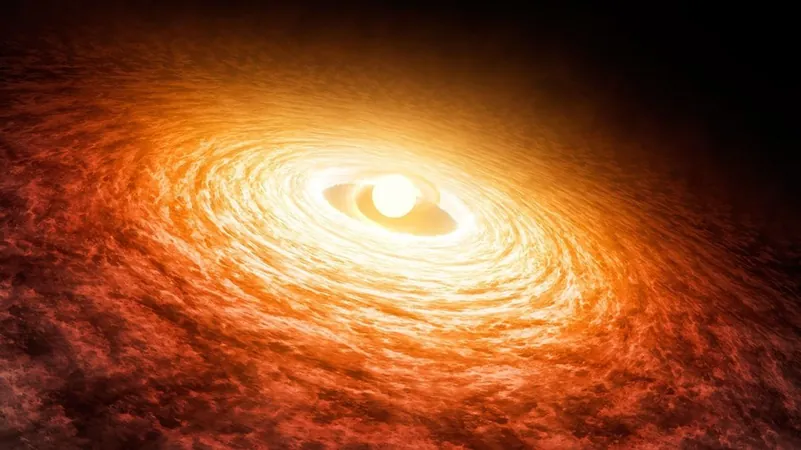
Hubble Telescope Unveils Hot Secrets of FU Orionis: Are Planets in Danger?
2024-11-26
Author: John Tan
In a remarkable revelation, astronomers revisited a celestial enigma first observed in 1936 involving FU Orionis, a dim star nestled within the Orion constellation. This unassuming star shocked the astronomical community when it brightened exponentially, demonstrating an increase in luminosity by a staggering factor of 100 in just a few months—outshining our Sun by 100 times at its peak.
This unprecedented brightness was unlike any previously documented for young stars, prompting a flurry of research and intrigue. Subsequent investigations uncovered that FU Orionis is a binary star enveloped by a circumstellar disk. This structure is crucial, as the brightening episodes are predominantly caused by the star accreting mass from this disk. In fact, FU Orionis serves as a prototypical case for an entire class of variable young stars known as FU Ori stars, which are categorized as a sub-class of T Tauri stars—young, pre-main-sequence stars still in their formative stages.
However, until recently, the mechanisms behind the accretion and its interface with the surrounding disk remained a puzzle. Despite progress in modeling the star's accretion dynamics, astronomers have struggled to visually capture the elusive boundary where the disk meets the star—until now.
Utilizing the Hubble Space Telescope, researchers employed the COS (Cosmic Origins Spectrograph) and STIS (Space Telescope Imaging Spectrograph) instruments to scrutinize FU Orionis, revealing groundbreaking insights published in The Astrophysical Journal Letters. Lead author Adolfo Carvalho, a PhD candidate in Astronomy at Caltech, reported striking findings about the accretion shock and the temperature dynamics at the star-disk boundary.
Unlike typical T Tauri stars, FU Ori stars experience periodic disk instabilities due to factors like a disproportionately large disk size, binary star dynamics, or inflowing material. These instabilities lead to rapid fluctuations in accretion rates, resulting in a more chaotic and hotter interface. While classical T Tauri stars attract material along their magnetic field lines onto their poles, FU Ori stars present a different narrative due to their closer accretion disks.
In a feat of astronomical observation, the researchers detected an unexpectedly high temperature in the accretion shock zone—the region where material from the disk collides with the star’s surface. Their data showed temperatures soaring to an astounding 16,000 kelvins, nearly three times that of our Sun's surface temperature, significantly higher than previous models predicted. This revelation not only challenges existing theories but also brings with it implications for our understanding of how young stars evolve.
The revised viscous disk accretion model suggested by the research team illustrates how incoming disk material collides with stellar surfaces, producing ultraviolet light. This high-energy emission indicates that material enters at speeds of about 40 km/s, aligning perfectly with simulated accretion processes.
Moreover, the findings raise critical questions about exoplanetary formation in such high-energy environments. As researchers ponder the possibilities, they wonder whether the intense ultraviolet flares from FU Orionis could hinder planet formation or influence the chemistry of developing worlds. Carvalho reflects that while the situation presents mixed outcomes for planetary formation, it spells potential doom for planets too close to the chaotic brilliance of FU Orionis. Within just a few outbursts, these rocky planets might spiral inward and risk merging with the star, effectively “frying” any potential for habitability.
This new perspective on FU Orionis not only enhances our comprehension of stellar evolution but also opens up new avenues for understanding how the dynamic environments around young stars can shape the planets that may one day orbit them. As astronomers continue to unveil the mysteries of the cosmos, they remind us that in the universe, every shed light may harbor both the creation and destruction of worlds.


 Brasil (PT)
Brasil (PT)
 Canada (EN)
Canada (EN)
 Chile (ES)
Chile (ES)
 España (ES)
España (ES)
 France (FR)
France (FR)
 Hong Kong (EN)
Hong Kong (EN)
 Italia (IT)
Italia (IT)
 日本 (JA)
日本 (JA)
 Magyarország (HU)
Magyarország (HU)
 Norge (NO)
Norge (NO)
 Polska (PL)
Polska (PL)
 Schweiz (DE)
Schweiz (DE)
 Singapore (EN)
Singapore (EN)
 Sverige (SV)
Sverige (SV)
 Suomi (FI)
Suomi (FI)
 Türkiye (TR)
Türkiye (TR)